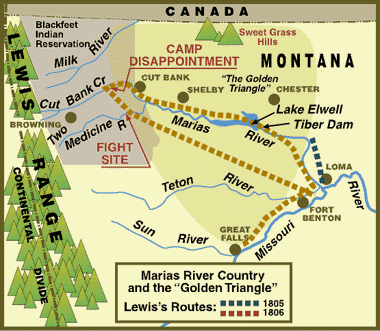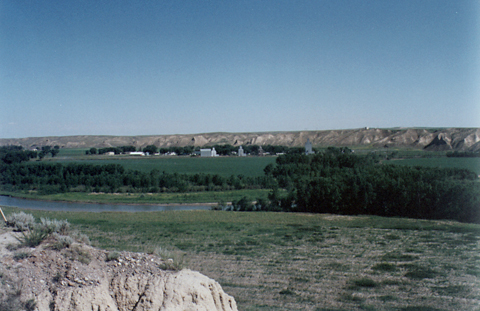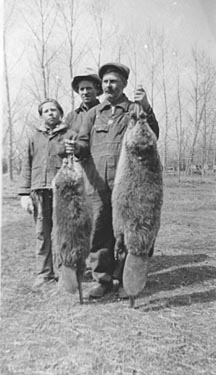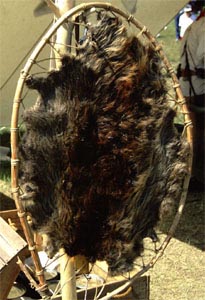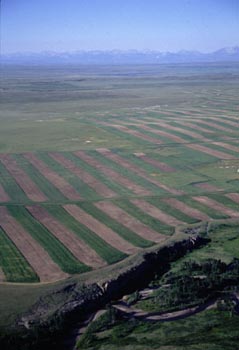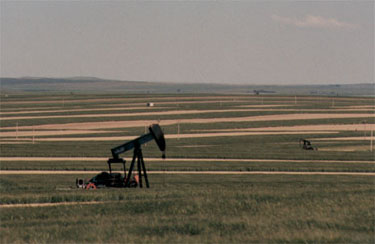The community of Loma, Montana, looking eastward from the “top of the heights” where Lewis and Clark stood. The Marias River, now in the foreground, was probably closer to those grain elevators, near the cottonwood trees in the background. Today it empties into the Missouri less than a quarter of a mile to the right of the photo.
Then shalt thou lay up gold as dust,
and the gold of Ophir as the stones of the brooks.
Ophir, Montana (Loma)
By 1847 the crest of the fur market was past, but in that year a new trading post, soon to be called Fort Benton, was established 22 river-miles upstream from the mouth of the Marias. Its location was considered the head of seasonal navigation on the Missouri River. After 1863, when gold was discovered in present-day Idaho and southwestern Montana, Fort Benton became the commercial hub of wagon-train traffic that reached south to Virginia City, Montana, and west to Walla Walla, Washington. The prosperity of Fort Benton was limited only by some “stones of the brooks” called Black Bluffs Rapids, just three miles above the Marias, which prevented larger and more profitable steamboats from reaching the town after mid-summer.
In 1864, a small group of entrepreneurs who had already proved themselves on the frontier, conceived the idea of building a new city at the mouth of the Marias, which would replace Fort Benton as the trade center on the Upper Missouri. They named it Ophir, the Biblical metonymy for gold.[1]The name of that fabulous city, that “golden wedge of Ophir” (Isaiah 13:12), is invoked nine times in the Old Testament as a symbol of prosperity and magnificence, and the source of … Continue reading
It was a grandiose plan. The first territorial legislature, meeting at Bannack in 1864, authorized the incorporation of the new town that would occupy both the north and south sides of the Marias as far upstream as the mouth of the Teton, as well as the opposite bank of the Missouri. A dozen related companies were formed, including one to build a wagon road and later a railroad around the Great Falls of the Missouri, a couple of ferry companies, and a steamboat company to connect Great Falls with Gallatin City, then a-borning at the Three Forks of the Missouri. It is said there was even talk of a university.
Construction was begun early in the spring of 1866 with the erection of several log cabins. In late May, a party of ten or eleven men was cutting more logs three miles up the Marias when a large band of Blood Indians, part of the Blackfeet Nation, came by, possibly headed for Fort Benton to avenge the recent murder of nine men of their tribe. There was a brief battle, and all the white men were killed. No one knows who started it—it may have been just a tragic misunderstanding—but the surviving entrepreneurs were jolted awake, and the city of Ophir faded from memory as quickly as the sweetest of dreams.
The attraction of the place remained, but nothing much happened until 1887, when a railroad was built linking Jim Hill’s Great Northern Railroad with Helena, and a way station called Marias was established at the mouth of the Teton. When the rails were relocated closer to the Missouri River in 1899, a new station was situated on the north side and called Lower Marias, which railroad telegraphers abbreviated as LOMA. The station drew farm traffic and a few settlers, so that by 1911 it had a population of 33 and thus deserved a post office, for a while called Chappell. The rail line was abandoned in 1982, leaving the little community of Loma as a quiet “way station” on U.S. 87.
So much for Lewis and Clark’s vision of a trading post, and of a paper-thin, golden dream of Ophir.
Soft Gold (Fur)
These two beavers were trapped in Marias River country sometime in the 1940s. The second-heaviest rodent in the world, a beaver can weigh as much as 66 pounds.[2]The heaviest is the capybara, of South America, which can weigh in at 146 pounds. The one on the right may not have been a record, but it could well have raised the average.
Beginning around the middle of the 16th century, felt manufactured from the fine undercoat shaved from the pelt of the beaver became the miracle material for hats among men in all walks–and weathers–of life. It was durable, it held its shape, and above all, it was waterproof. The demand for it was so great in Europe that beavers were almost extirpated from their prime habitats in Scandanavia and Russia, so in the early 17th century the European fur industry turned to North America.
Therefore the most welcome news about the Louisiana Territory that the Corps of Discovery brought back was the remarkable abundance of beaver throughout much of the northwest, especially in the vicinity of the Three Forks of the Missouri, and in the valleys of the Jefferson and Beaverhead Rivers. Indeed, wherever the riparian timber thinned out, the relative absence of beaver was conspicuous. On his exploratory journey to the headwaters of the Marias in July 1806, Lewis bagged just one beaver–for its meat.
Although the golden age of the fur trade was past its peak when Fort Benton was established in 1850, furs remained the basis of its economy as a centrally located trading post for another couple of decades. The hottest commodities included not only beaver but also wolf, coyote, otter, marten, and fisher, which were all valued for their warmth and beauty. A comment in the Fort Benton Illustrated Almanac for 1878 summarizes this transitional era.
Beaver Plew
Legal Tender
Dean Hellinger photo, courtesy of the Great Falls Lewis & Clark Encampment.
A beaver pelt, or “plew” (Canadian French, pelu, from the French adjective poilu, hairy), mounted as early trappers would have stretched it for drying. Pictured above is a “coat beaver” plew, with the hair still on. A dried plew with hair removed was called a “parchment beaver.” At the beginnings of the Western fur trade in the late 1700s until its decline in the early 1840s, dollars were useless in this part of the realm, while beaver “parchments” had a comprehensible value in trade. Twenty parchments for a gun was a real deal; a price of fifty dollars for the same gun was just talk. Pelts other than beaver could be valued in terms of “made beaver.” A marten might be valued at two made beaver; a white weasel (ermine) pelt might be worth eight or more made beaver.
Primping for a Heavy Date
Video © Dean Hellinger.
Until the past three years, the inhabitants of Benton were almost exclusively engaged in fur trading. . . . While in some respects the fur trade was of great advantage to Benton, it was also a detriment to the welfare of the town. It furnished profitable and congenial employment to a large class of adventurous men, who squandered their earnings as rapidly as they received them, and this together with the money spent by the fur dealers who annually visited the town, and by travelers awaiting the arrival or departure of steamers, made trade good and cash plenty.
It was partly the continuing decline in the market for furs that caused the writer to use the past tense, but the animal population had also diminished considerably. Indeed, early in the 1880s the Montana Legislature enacted the Territory’s first game law, prohibiting the trapping of beaver for a part of each year, primarily to preserve the beaver population as a commercial resource. The first authorized season for beaver trapping was announced in 1895.
Beavers, however, are rodents, and as such are opportunistic and adaptable animals. They are survivors, in the long run subject to few predators other than humans. In places such as the C.M. Russell National Wildlife Refuge along the Missouri River in eastern Montana, it is believed that their numbers today at least equal those in Lewis and Clark’s era.
The main factor affecting beaver numbers now is the limit of tolerance of farmers and other landowners, even in suburban habitats, and trapping serves as the most practical management alternative. In the past few decades, annual beaver harvests in Montana alone have ranged from a low of 5,000 to a high of around 18,000. The total annual harvest throughout the USA ranges between 100,000 and 200,000 of the species.
Hard Gold (Wheat)
On 5 June 1805, as he set out to explore the lower part of the “north fork,” Meriwether Lewis made note of the quality of the soil, as usual:
It is astonishing what a quantity of water it takes to saturate the soil of this country, the earth of the plains are now opened in large crivices in many places and yet looks like a rich loam.
Again, on 7 June 1805:
Notwithstanding the rain that has now fallen the earth of these bluffs is not wet to a greater debth than 2 inches; in it’s present state it is precisely like walking over frozan grownd which is thawed to small debth and slips equally as bad. this clay not only appears to require more water to saturate it as I before observed than any earth I ever observed but when saturated it appears on the other hand to yeald it’s moisture with equal difficulty.
Precision farming employs global positioning systems (GPS) and geographic information systems (GIS) to measure yield as a crop is being harvested, locate spots in a field where yield is low, and automatically adjust seeding and fertilizer application rates accordingly the next time the field is planted. Tractors are air-conditioned, dust-proofed, computer-aided offices on wheels that are equal to the challenges of this beautiful but rugged land.
Of course, even precision farming doesn’t always insure financial success. In 1996, the price of wheat was around $4 per bushel. In 1998, partly owing to a recession throughout Asia, it dropped to between $1.92 and $2.22 per bushel, while the cost was still $3 per bushel to grow it. That misfortune was compounded by a plague of sawflies that chew through the stems of the plant and cause it to fall over, making the grain more costly to harvest.
“The buffalo commons may be here,” says farmer Dean Hellinger. “It is a very serious situation.”
Lewis might have been surprised that this land proved tillable at all, not to mention the mode of agriculture that would be practiced. But he and his contemporaries, and especially his commander-in-chief, Thomas Jefferson, would happily have taken some of the credit for the outcome. The long-sought Northwest Passage, at least as a nearly continuous waterway, proved to be nonexistent, but the market for the Golden Triangle’s grain is the same one Jefferson was courting—in modern terms, the Pacific Rim.
Indeed, the silty soil here is so fine that it traps rainwater near the surface, whereas looser, more porous soil would allow it to filter down deeper. Consequently, it is so slippery and sticky when wet that even huge farm machines are immobilized. No wonder it’s called gumbo. Lewis was right: It looks pretty good, but it’s basically just a means of propping up a wheat stalk so that fertilizer, herbicides, and pesticides can be applied. Basic dryland methods such as strip farming, combined with modern precision farming technology, sometimes called prescription farming, made the so-called Golden Triangle one of the richest wheat-producing areas anywhere.
During the 20th century several techniques have evolved for dryland cultivation. One of those is strip farming, in which a field is divided into strips of equal width, with alternate strips permitted to lie fallow—that is, plowed but unseeded—for one or two years in order to store up moisture. Windblown topsoil from the fallow strips collects in the adjacent planted strips. The result is the crisp geometry of fields throughout the northern plains in the western United States and Canada.(See Always the Wind.) Some of the high-tech tractors used to cultivate these mile-long strips are guided by laser-beam devices, but the experienced farmer does it by eye and by feel.
Liquid Gold (Water)
Because of the “quantity of water it takes to saturate the soil of this country,” throughout most of the 19th century most farmers overleaped the dry land between the 98th meridian—the eastern third of the Dakotas—and the Rocky Mountains. Then, around 1890, with new farming methods and machines at their disposal, and federal legislation to encourage them, they began to break ground even in Marias River country. For a few years it seemed to many that the Jeffersonian dream of a prosperous agrarian lifestyle was finally coming true in the West.
But the wet years—the first fifteen of the century—brought floods that scoured crops from the narrow but fertile river bottoms, and made the gumbo on the highlands hard to till. In the dry years, from 1915 into the twenties, dust storms were more common than rainstorms. In June 1908, a flood year, the Missouri River raged along at 107,000 cubic feet per second past Fort Benton, 22 miles upstream from the mouth of the Marias. In 1919, at the height of the drought, it trickled by at a pitiful 1,420 cfs.
Major floods occurred in the Missouri River basin in 1844, 1881,1903, 1908, 1915, 1927, and 1948. The Marias River drainage contributed to the problem by adding spring runoff from the northern part of the Rockies. Something had to be done and the Tiber Dam was built.
Black Gold (Oil)
The primary stage in petroleum recovery is the pumping of crude oil pools,which amount to about two percent of the total available resource. Secondary recovery uses water to float oil from surrounding sands. Tertiary recovery uses acid and explosives to “wring out the rocks.” The South Field, on the Blackfeet Reservation, is in secondary recovery.
The Cut Bank Field, where these pumps work amid strips of grain, has reached the tertiary stage.
Meriwether Lewis did not have any kind of gold in mind, of course, when he toured the valley of the river he called Maria’s,(see Lewis on the Marias) and he certainly could not have imagined that beneath its questionable soil lay vast pools of wealth, a black bonanza—petroleum.
The market for petroleum products in America and Europe emerged during the 1850s, when crude oil was first distilled into kerosene to become the favored lamp fuel, replacing sooty animal fats such as whale oil. Natural seeps from oil shale were discovered at several sites in Montana in the 1860s, and an oil boom within the present boundaries of Glacier National Park had a short life between 1890 and 1910. With the advent of the automobile after 1900, the demand for gasoline and lubricating oil expanded proportionately, and so did exploration. In 1910, the Great Northern Railroad began converting some of its coal-burning locomotives to oil, which encouraged further efforts in northern and northwestern Montana.
A few wildcatters brought in a little oil, but nothing commercially viable, and onlookers temporarily concluded that the real gold in “Triangle Country” was on top of the ground, not under it.
The first major oil discovery in Montana was made north of Shelby in 1922. Called the Kevin-Sunburst Field, it was the state’s most prolific producer until 1934, when the Cut Bank Field was opened. Prosperity saw the upper Marias country through the Great Depression, peaked in the 1960s, and has been in a steady decline since then.
Hidden Gold (Dinosaurs)
Among the “objects worthy of notice” listed by Thomas Jefferson in his instructions to Meriwether Lewis were “the remains or accounts of any [animals] which may be deemed rare or extinct,” such as the mammoth and the “megalony”—Jefferson’s hypothetical “enormous animal incognitum.”[3]Letters of the Lewis and Clark Expedition with Related Documents, 1783-1854; 2nd ed. (2 vols., Urbana: University of Illinois Press, 1978),16, 126-32.
Meriwether Lewis, his innate curiosity combined with an exceptional capacity for concentration and analysis, learned as much as Jefferson and Caspar Wistar could teach him about the new science which nearly fifty years later would be called paleontology. En route down the Ohio River in the autumn of 1803, he made a short side trip to Big Bone Lick, near Covington, Kentucky, which had recently been excavated by a Cincinnati physician, Dr. William Goforth. Lewis wrote Jefferson the details of his visit, promising to send him a tusk of a mammoth, two “grinders,” and several other specimens. Unfortunately, the shipment went astray. In 1807 Jefferson hired William Clark to supervise a new excavation there.
During the expedition, however, the men found only a few fossils. On 30 May 1804, they reportedly picked up a “petrification” of some sort in the vicinity of Tavern Cave, in Missouri, but it has long since been lost or misplaced. And on 25 July 1806, Clark found what was probably a dinosaur bone in the bank of the Yellowstone River in the Cretaceous Hell Creek sandstone formation near Billings, Montana, but it too has disappeared. Clark guessed it was the rib of a prehistoric fish; the name dinosaur was not to enter scientific vocabulary until 1842 (see Dinosaur Country).
Notes
| ↑1 | The name of that fabulous city, that “golden wedge of Ophir” (Isaiah 13:12), is invoked nine times in the Old Testament as a symbol of prosperity and magnificence, and the source of shiploads of tributes for King Solomon. Biblical scholars have long disagreed on its whereabouts, but most now favor Somaliland, on the eastern coast of Africa. |
|---|---|
| ↑2 | The heaviest is the capybara, of South America, which can weigh in at 146 pounds. |
| ↑3 | Letters of the Lewis and Clark Expedition with Related Documents, 1783-1854; 2nd ed. (2 vols., Urbana: University of Illinois Press, 1978),16, 126-32. |
Experience the Lewis and Clark Trail
The Lewis and Clark Trail Experience—our sister site at lewisandclark.travel—connects the world to people and places on the Lewis and Clark Trail.
Discover More
- The Lewis and Clark Expedition: Day by Day by Gary E. Moulton (University of Nebraska Press, 2018). The story in prose, 14 May 1804–23 September 1806.
- The Lewis and Clark Journals: An American Epic of Discovery (abridged) by Gary E. Moulton (University of Nebraska Press, 2003). Selected journal excerpts, 14 May 1804–23 September 1806.
- The Lewis and Clark Journals. by Gary E. Moulton (University of Nebraska Press, 1983–2001). The complete story in 13 volumes.
